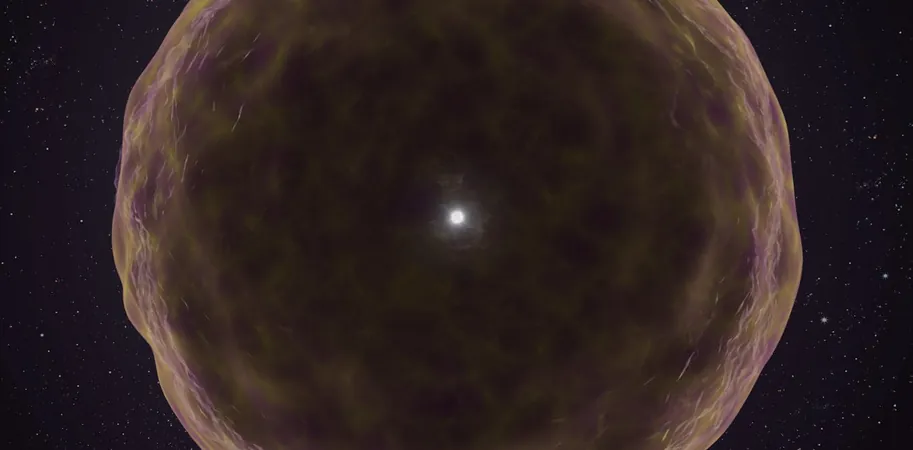
Gigantic Supernova Discovery Shakes Up Cosmic Understanding!
2025-08-26
Author: Yu
A Cosmic Spectacle Unveiled!
In the grand theater of the universe, stars dramatically conclude their life cycles in breathtaking explosions known as supernovae. These cataclysmic events not only illuminate the cosmos but also scatter essential materials that will ultimately give rise to new celestial bodies in an endless cycle of creation and destruction.
Groundbreaking Observation of SN2021yfj!
In a stunning revelation, astronomers recently observed the supernova SN2021yfj, a dazzling event located two billion light-years away. Lasting over a month, this cosmic explosion showcased unprecedented visible traces of heavy elements like argon, silicon, and sulfur from its very onset—something never seen before in previous stellar explosions.
Onion Layers of Cosmic Material!
Supernovae are notorious for ejecting stellar material into space, closely resembling the onion-like structure of the star pre-explosion. The lighter elements like hydrogen and helium inhabit the star's outer layers, while heavier elements like iron and silicon nestle within. However, many massive stars can lose portions of their outer layers during their lifespans, either through solar winds or significant eruptions.
The Vast Playground of the Cosmos!
With an estimated two trillion galaxies teeming with stars, the universe is a treasure trove for scientists eager to unravel its mysteries. While not all stars culminate in explosive endings, the sheer number that do allows researchers to study their unique structures and chemical compositions.
Anomalous Chemical Signatures!
The luminosity and behavior of the newly discovered supernova mirrored other well-studied explosions. Its electromagnetic spectra revealed a thick inner layer expelled during the explosion, which was unexpectedly juxtaposed against traces of lighter elements from the star's outer layers.
What Lies Beneath?!
Measurements indicated a layer velocity of about 1,000 km/s, consistent with massive stars identified as progenitors of similar supernovae. The findings revealed that the thick, silicon-rich layer was indeed more massive than our Sun yet still less than the collective material ejected in the explosion.
New Questions Arise!
This groundbreaking discovery has ignited a wave of inquiries within the astronomical community. How do some stars strip down to their innermost layers? Why are lighter elements detected if only the heavy ones are expected?
Challenging Existing Theories!
This newly classified supernova raises fundamental challenges to our current theories on massive star evolution. Conventional models struggle to account for how stars can lose so much mass, especially when heavy element formation is involved. An alternative scenario proposes that SN2021yfj may be part of a binary system, where a companion star generates strong winds that strip the principal star down.
A Possible Tale of Immense Stars!
Another thrilling possibility is that SN2021yfj originated from an exceedingly massive star, potentially up to 140 times the mass of the Sun. Instabilities within such a giant could create massive shells that collide as the star collapses into a black hole, preventing further release of material.
The Search for Similar Explosions Continues!
To unravel these cosmic enigmas, scientists are eager to discover more instances like SN2021yfj. However, given the extreme rarity of such supernovae—at less than a 0.00001% chance of discovery—our quest for stellar understanding remains a daunting challenge!



 Brasil (PT)
Brasil (PT)
 Canada (EN)
Canada (EN)
 Chile (ES)
Chile (ES)
 Česko (CS)
Česko (CS)
 대한민국 (KO)
대한민국 (KO)
 España (ES)
España (ES)
 France (FR)
France (FR)
 Hong Kong (EN)
Hong Kong (EN)
 Italia (IT)
Italia (IT)
 日本 (JA)
日本 (JA)
 Magyarország (HU)
Magyarország (HU)
 Norge (NO)
Norge (NO)
 Polska (PL)
Polska (PL)
 Schweiz (DE)
Schweiz (DE)
 Singapore (EN)
Singapore (EN)
 Sverige (SV)
Sverige (SV)
 Suomi (FI)
Suomi (FI)
 Türkiye (TR)
Türkiye (TR)
 الإمارات العربية المتحدة (AR)
الإمارات العربية المتحدة (AR)